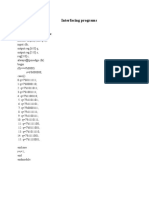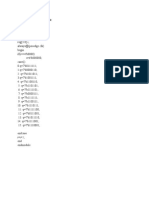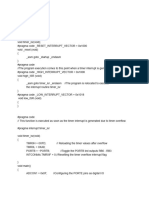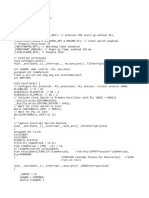Fpga With ps2 Keyboard
Uploaded by
Leslie WrightFpga With ps2 Keyboard
Uploaded by
Leslie Wrightmodule ps2(output reg [7:0]data_out,output reg parity,input data_in,input clk);
reg start,stop;
reg [7:0] data_shift;
reg[3:0] data_count='b0;
reg enable;
always@(enable==1)data_out=data_shift;
always @(negedge clk)
begin
if(data_count<10)
data_count=data_count+1;
else
data_count=0;
end
always@(negedge clk)
if(data_count==0)
begin
start='b0;
stop='b0;
enable='b0;
end
else if(data_count<9)
begin
data_shift<={data_in,data_shift[7:1]};
// else if(data_count<10)
// begin
// data_shift[7]<=data_in;
// data_shift[6]<=data_shift[7];
// data_shift[5]<=data_shift[6];
// data_shift[4]<=data_shift[5];
// data_shift[3]<=data_shift[4];
// data_shift[2]<=data_shift[3];
// data_shift[1]<=data_shift[2];
// data_shift[0]<=data_shift[1];
end
else if(data_count==9)
begin
parity=^~(data_shift);
end
else if(data_count==10)
begin
start='b1;
stop='b1;
enable='b1;
end
else if
begin
data_shift='b0;
end
endmodule
//
//
//
//
//
//
//
//
//
//
//
//
//module ps2(
//input wire clk, // Clock pin form keyboard
//input wire data, //Data pin form keyboard
//output reg [7:0] led //Printing input data to led
//);
// reg [7:0] data_curr;
// reg [7:0] data_pre;
// reg [3:0] b;
// reg flag;
//
//initial
//begin
//b<=4'h1;
//flag<=1'b0;
//data_curr<=8'hf0;
//data_pre<=8'hf0;
//led<=8'hf0;
//end
//
//always @(negedge clk) //Activating at negative edge of clock from keyboard
//begin
//
//case(b)
//1:; //first bit
//2:data_curr[0]<=data;
//3:data_curr[1]<=data;
//4:data_curr[2]<=data;
//5:data_curr[3]<=data;
//6:data_curr[4]<=data;
//7:data_curr[5]<=data;
//8:data_curr[6]<=data;
//9:data_curr[7]<=data;
//10:flag<=1'b1; //Parity bit
//11:flag<=1'b0; //Ending bit
//
//endcase
// if(b<=10)
// b<=b+1;
//
// else if(b==11)
// b<=1;
//
//
//end
//
//always@(posedge flag) // Printing data obtained to led
//begin
//
// if(data_curr==8'hf0)
// led<=data_pre;
// else
// data_pre<=data_curr;
//end endmodule
You might also like
- FPGA Keyboard Interface - Embedded ThoughtsNo ratings yetFPGA Keyboard Interface - Embedded Thoughts29 pages
- Name: Aish Siddiqui Id: FA19-BEEE-0037 Lab: 09 Subject: MBS Task: 01 CodeNo ratings yetName: Aish Siddiqui Id: FA19-BEEE-0037 Lab: 09 Subject: MBS Task: 01 Code6 pages
- Hardware Interfaces To 8051: 1. LCD 2. Keyboard 3. ADC 4. DAC 5. Stepper Motor 6. DC MotorNo ratings yetHardware Interfaces To 8051: 1. LCD 2. Keyboard 3. ADC 4. DAC 5. Stepper Motor 6. DC Motor32 pages
- Display "Hello World"message Using Internal UARTNo ratings yetDisplay "Hello World"message Using Internal UART16 pages
- MCA Codeof pic microcontroller practicalNo ratings yetMCA Codeof pic microcontroller practical12 pages
- Pic 18f452 Implementation of Digital FiltersNo ratings yetPic 18f452 Implementation of Digital Filters5 pages
- Ee1672-Embedded Systems (Integrated Lab)No ratings yetEe1672-Embedded Systems (Integrated Lab)18 pages
- Spyglass® Known Problems and Solutions: This Document Describes The FollowingNo ratings yetSpyglass® Known Problems and Solutions: This Document Describes The Following82 pages
- Sue and Johnsy Had Their Studio, "Johnsy" Was Familiar For Joanna One Was From Maine The Other From California Met at English Street "Delmonico's,"No ratings yetSue and Johnsy Had Their Studio, "Johnsy" Was Familiar For Joanna One Was From Maine The Other From California Met at English Street "Delmonico's,"1 page
- Reduced Gigabit Media Independent Interface (Rgmii) : Page 1 of 8No ratings yetReduced Gigabit Media Independent Interface (Rgmii) : Page 1 of 88 pages
- Constituent Assembly Met For The First Time in New Delhi On 9 December, 1946No ratings yetConstituent Assembly Met For The First Time in New Delhi On 9 December, 19464 pages
- Search Results: 8b 10b Encoding Timing 8b 10b EncoderNo ratings yetSearch Results: 8b 10b Encoding Timing 8b 10b Encoder1 page
- Name: Aish Siddiqui Id: FA19-BEEE-0037 Lab: 09 Subject: MBS Task: 01 CodeName: Aish Siddiqui Id: FA19-BEEE-0037 Lab: 09 Subject: MBS Task: 01 Code
- Hardware Interfaces To 8051: 1. LCD 2. Keyboard 3. ADC 4. DAC 5. Stepper Motor 6. DC MotorHardware Interfaces To 8051: 1. LCD 2. Keyboard 3. ADC 4. DAC 5. Stepper Motor 6. DC Motor
- Computer Engineering Laboratory Solution PrimerFrom EverandComputer Engineering Laboratory Solution Primer
- Spyglass® Known Problems and Solutions: This Document Describes The FollowingSpyglass® Known Problems and Solutions: This Document Describes The Following
- Sue and Johnsy Had Their Studio, "Johnsy" Was Familiar For Joanna One Was From Maine The Other From California Met at English Street "Delmonico's,"Sue and Johnsy Had Their Studio, "Johnsy" Was Familiar For Joanna One Was From Maine The Other From California Met at English Street "Delmonico's,"
- Reduced Gigabit Media Independent Interface (Rgmii) : Page 1 of 8Reduced Gigabit Media Independent Interface (Rgmii) : Page 1 of 8
- Constituent Assembly Met For The First Time in New Delhi On 9 December, 1946Constituent Assembly Met For The First Time in New Delhi On 9 December, 1946
- Search Results: 8b 10b Encoding Timing 8b 10b EncoderSearch Results: 8b 10b Encoding Timing 8b 10b Encoder







































































